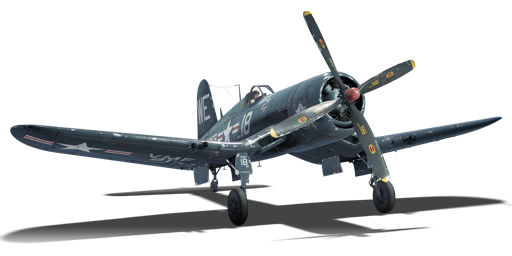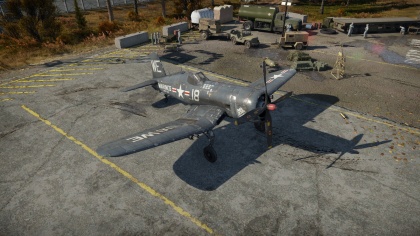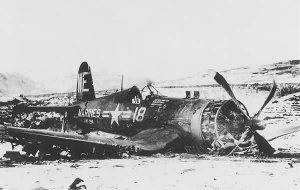Difference between revisions of "F4U-4B VMF-214"
CobraKingII (talk | contribs) |
CobraKingII (talk | contribs) (→History) (Tag: Visual edit) |
||
| Line 267: | Line 267: | ||
WE-18 is the Corsair that the War Thunder '''F4U-4B VMF-214''' is based on. It was an F4U-4B that was assigned to Marine Fighter Squadron 214 (VMF-214), and SSgt. Floyd P. Stocks was the plane captain for WE-18 starting in November 1948. In March 1950, VMF-214 flew 3,136.6 hours of syllabus training, and WE-18 had to have an engine change. A crew, lead by Stocks and SSgt. Titus Willis, completed a quick engine change (QEC). WE-18 was out of commission for one afternoon, and was ready the next morning. The pilot was Lt. Joe Bibby. | WE-18 is the Corsair that the War Thunder '''F4U-4B VMF-214''' is based on. It was an F4U-4B that was assigned to Marine Fighter Squadron 214 (VMF-214), and SSgt. Floyd P. Stocks was the plane captain for WE-18 starting in November 1948. In March 1950, VMF-214 flew 3,136.6 hours of syllabus training, and WE-18 had to have an engine change. A crew, lead by Stocks and SSgt. Titus Willis, completed a quick engine change (QEC). WE-18 was out of commission for one afternoon, and was ready the next morning. The pilot was Lt. Joe Bibby. | ||
[[File:F4U-4B WE-18.jpg|thumb|WE-18 after its crash on 26 October 1950. Note the mission markings on the fuselage.This image was published by a Chinese news agency.]] | [[File:F4U-4B WE-18.jpg|thumb|WE-18 after its crash on 26 October 1950. Note the mission markings on the fuselage.This image was published by a Chinese news agency.]] | ||
| − | Stocks later recounted in an email to ''koreanwaronline.com:''<blockquote>Other than that engine change I had very little trouble with her over the two years. I was very proud of her record.</blockquote>WE-18 was one of the Corsairs that took part in that initial raid near Inchon on 3 August 1950, taking off from the USS ''Sicily''. WE-18 crash-landed in the Chosin Reservoir on 26 October 1950. Bibby was forced to make a wheels-up landing after being damaged by ground fire. Bibby survived the crash, and was rescued by the Marines shortly afterwards. They threw hand grenades into the cockpit and fuselage, destroying the aircraft. By the time it crashed, WE-18 had the marks of 52 successful combat missions painted on the fuselage under the cockpit. | + | Stocks later recounted in an email to ''koreanwaronline.com:''<blockquote>"Other than that engine change I had very little trouble with her over the two years. I was very proud of her record."</blockquote>WE-18 was one of the Corsairs that took part in that initial raid near Inchon on 3 August 1950, taking off from the USS ''Sicily''. WE-18 crash-landed in the Chosin Reservoir on 26 October 1950. Bibby was forced to make a wheels-up landing after being damaged by ground fire. Bibby survived the crash, and was rescued by the Marines shortly afterwards. They threw hand grenades into the cockpit and fuselage, destroying the aircraft. By the time it crashed, WE-18 had the marks of 52 successful combat missions painted on the fuselage under the cockpit. |
| − | Stocks' log from 26 October 1950:<blockquote>WE18 didn't return from a mission. I took care of that beautiful Corsair for two years. Now she is gone. I'll never forget WE18. Lt. Joe Bibby was the pilot. He made a wheels-up landing near our Marines. He is ok. They threw a few hand grenades inside the fuselage and cockpit to complete the destruction.</blockquote> | + | Stocks' log from 26 October 1950:<blockquote>"WE18 didn't return from a mission. I took care of that beautiful Corsair for two years. Now she is gone. I'll never forget WE18. Lt. Joe Bibby was the pilot. He made a wheels-up landing near our Marines. He is ok. They threw a few hand grenades inside the fuselage and cockpit to complete the destruction."</blockquote> |
== Media == | == Media == | ||
Revision as of 16:16, 26 September 2020
Contents
| This page is about the gift naval fighter F4U-4B VMF-214. For the regular version, see F4U-4B. For other uses, see F4U (Family). |
Description
The F4U-4B VMF-214 is a gift rank IV American naval fighter
with a battle rating of 5.7 (AB/RB/SB). It was introduced in Update 1.79 "Project X". It's an Xbox exclusive vehicle obtained by buying a pack.
General info
Flight Performance
| Characteristics | |||||||
|---|---|---|---|---|---|---|---|
| Stock | |||||||
| Max Speed (km/h at 5,000 m) |
Max altitude (meters) |
Turn time (seconds) |
Rate of climb (meters/second) |
Take-off run (meters) | |||
| AB | RB | AB | RB | AB | RB | ||
| 688 | 648 | 11,500 | 21.3 | 21.6 | 12.2 | 14.6 | 200 |
| Upgraded | |||||||
| Max Speed (km/h at 5,000 m) |
Max altitude (meters) | Turn time (seconds) | Rate of climb (meters/second) |
Take-off run (meters) | |||
| AB | RB | AB | RB | AB | RB | ||
| 732 | 697 | 11,500 | 19.1 | 20.0 | 25.1 | 19.0 | 200 |
Details
| Features | ||||
|---|---|---|---|---|
| Combat flap | Take-off flap | Landing flap | Air brakes | Arrestor gear |
| ✓ | ✓ | ✓ | X | ✓ |
| Limits | ||||
|---|---|---|---|---|
| Wing-break speed (km/h) |
Gear limit (km/h) |
Combat flap (km/h) |
Max Static G | |
| + | - | |||
| 0 | 730 | 470 | ~?? | ~? |
| Optimal velocities | |||
|---|---|---|---|
| Ailerons (km/h) |
Rudder (km/h) |
Elevators (km/h) |
Radiator (km/h) |
| < 450 | < 200 | < 500 | > 450 |
| Compressor (RB/SB) | ||
|---|---|---|
| Setting 1 | ||
| Optimal altitude | 100% Engine power | WEP Engine power |
| 2,133 m | 2,300 hp | 2,799 hp |
| Setting 2 | ||
| Optimal altitude | 100% Engine power | WEP Engine power |
| 5,791 m | 2,000 hp | 2,434 hp |
Survivability and armour
- 3 mm Steel - Upper cowling engine protection plates x 2
- 8 mm Steel - Pilot's seat back protection plate
- 12.7 mm Steel - Pilot's seat headrest
- 38 mm Bulletproof glass - Windshield
Armaments
Offensive armament
The F4U-4B VMF-214 is armed with:
- 4 х 20 mm AN/M3 cannons, wing-mounted (246 rpg = 984 total)
Suspended armament
The F4U-4B VMF-214 can be outfitted with the following ordinance:
- Without load
- 4 x 250 lb AN-M57 bombs + 2 x 500 lb AN-M64A1 bombs (2,000 lb total)
- 2 x 1,000 lb AN-M65A1 bombs (2,000 lb total)
- 8 x HVAR rockets
Usage in battles
The F4U-4B should be flown primarily at low altitude because its engine lacks power at higher altitudes. Here, it boasts an impressive climb rate (about 25 m/s when spaded), very good acceleration, and a high top speed. You should aim to be around 3-4km at the start of the battle and go after low enemies using boom and zoom tactics, then use your speed to outrun anyone who dives on you. You can then use your engine power and energy retention to gain an energy advantage over them and easily kill them. If you find yourself in a tough situation, don't be afraid to go a bit aggressive because this plane accelerates very well at low altitude and the extremely powerful guns makes it easy to secure kills quickly, but don't stall yourself out at the deck amidst a cloud of enemies since you'll be an easy kill.
Specific enemies worth noting
This plane can easily dogfight with Fw 190 Ds/152s, Tempest Mk Vs, Sea Furies, and similar planes, can dogfight with difficulty with Bf 109s and similar, and should avoid dog-fighting unless as an absolute last resort against Spitfires, Ki-84s, A7Ms, N1Ks, and similar. Fortunately, the F4U-4B is usually faster than most planes it can't dogfight. It's far faster than most Japanese and Italian props and all Spitfires up to the Mk 22 at low altitude. In an up-tier against superprops like Tempest IIs, Mk 24s, and P-51Hs and F8Fs if you get a mixed battle, you have to rely on coming in with an advantage as with any other plane in an uptier, though this is made easier with the F4U-4B's excellent top speed.
The F4U-4B is devastating in the right hands, and is one of the best planes the US tech tree has to offer.
Counter-tactics
You're best off engaging the F4U-4B at higher altitudes where its performance suffers. You can also try bleeding their energy in hard vertical maneuvers where it struggles, but be careful while doing this especially at low altitude since a potential opponent can still use the Corsair's stall characteristics combined with its engine power to get a shot off, which can be devastating no matter how short a burst.
Manual Engine Control
| MEC elements | ||||||
|---|---|---|---|---|---|---|
| Mixer | Pitch | Radiator | Supercharger | Turbocharger | ||
| Oil | Water | Type | ||||
| Controllable | Not controllable | Not controllable | Not controllable | Separate | Controllable | Not controllable |
Modules
| Tier | Flight performance | Survivability | Weaponry | ||
|---|---|---|---|---|---|
| I | Fuselage Repair | Radiator | Offensive 20 mm | FMBC mk.1 | |
| II | Compressor | Airframe | |||
| III | Wings Repair | Engine | New 20 mm Cannons | FLBC mk.1 | |
| IV | G-Suit | Engine Injection | Cover | FRC mk.2 | |
| This is a premium vehicle: all modifications are unlocked on purchase | |||||
Pros and cons
Pros:
- Excellent guns with high muzzle velocity allowing long range snipes
- Large ammo capacity, nearly 1,000 rounds in total altogether
- Very good performance overall at low altitude
- Extremely fast
- Good roll rate
- Fantastic stall characteristics, especially with flaps
- Very good instantaneous turn at high speeds
- Lenient stock grind
Cons:
- Does not turn well at lower speeds
- Rudder loses effectiveness at high speed, making it difficult to hit shots
- Rapidly loses performance at high altitude
- Flaps rip easily
- Guns when stock are inaccurate and easily jam
History
F4U-4B
The F4U-4B was a modification of the F4U-4. The F4U-4 was based on the F4U-1A Corsair. In order to improve and modernize the Corsair, so it would be able to fight the new Japanese planes in the Pacific, a number of changes were made. One of the major changes was the engine. The Pratt and Whitney R-2800-8W engine was replaced by the more powerful R-2800-18W engine. This -18W engine boosted the speed of the Corsair by up to 46.3 kph (25 kn, 28.76 mph). When injected with an alcohol/water mixture, the performance could be boosted even further. In order for the propeller to be able to handle the more powerful engine, the propeller had to be changed from 3 blades to 4 blades. Modifications to the fuselage were required, including the addition of a scoop to the lower engine cowling. In addition, the cockpit was completely redesigned. The F4U-4 was armed with six .50 in machine guns, up to 4,000 lbs of bombs and/or eight 5 in rockets.
A variant was to be created for the British Fleet Air Arm of the Royal Navy. It was called the F4U-4C, but none were delivered to the Fleet Air Arm, for whatever reason. The F4U-4C was then redesignated the F4U-4B. The only major difference between the F4U-4 and the F4U-4B was a change of primary armament. The -4B replaced the six .50 in machine guns with four 20 mm cannons. The F4U-4B was used by the US Navy and Marine Corps.
VMF-214
Marine Fighter Squadron 214 (VMF-214), the "Blacksheep" squadron, was aboard the USS Badoeng Strait (CVE-116), on the way to Hawaii, when the Korean War started. The squadron of eight F4U-4B Corsairs was transferred to the USS Sicily (CVE-118), becoming the first Marine Corps squadron to see action in Korea when they attacked ground targets near Inchon on 3 August 1950. On that raid, the Corsairs used bombs and rockets, and then made a several strafing passes. VMF-214 conducted two combat tours in Korea from USS Badoeng Strait and USS Boxer. The squadron participated in the Inchon Landing and the withdrawal from the Chosin Reservoir. The squadron provided constant air support for the friendly ground forces, interdicting supply lines, destroying enemy armor, and destroying fortifications.
F4U-4B WE-18
WE-18 is the Corsair that the War Thunder F4U-4B VMF-214 is based on. It was an F4U-4B that was assigned to Marine Fighter Squadron 214 (VMF-214), and SSgt. Floyd P. Stocks was the plane captain for WE-18 starting in November 1948. In March 1950, VMF-214 flew 3,136.6 hours of syllabus training, and WE-18 had to have an engine change. A crew, lead by Stocks and SSgt. Titus Willis, completed a quick engine change (QEC). WE-18 was out of commission for one afternoon, and was ready the next morning. The pilot was Lt. Joe Bibby.
"Other than that engine change I had very little trouble with her over the two years. I was very proud of her record."WE-18 was one of the Corsairs that took part in that initial raid near Inchon on 3 August 1950, taking off from the USS Sicily. WE-18 crash-landed in the Chosin Reservoir on 26 October 1950. Bibby was forced to make a wheels-up landing after being damaged by ground fire. Bibby survived the crash, and was rescued by the Marines shortly afterwards. They threw hand grenades into the cockpit and fuselage, destroying the aircraft. By the time it crashed, WE-18 had the marks of 52 successful combat missions painted on the fuselage under the cockpit. Stocks' log from 26 October 1950:
"WE18 didn't return from a mission. I took care of that beautiful Corsair for two years. Now she is gone. I'll never forget WE18. Lt. Joe Bibby was the pilot. He made a wheels-up landing near our Marines. He is ok. They threw a few hand grenades inside the fuselage and cockpit to complete the destruction."
Media
Excellent additions to the article would be video guides, screenshots from the game, and photos.
See also
External links
Paste links to sources and external resources, such as:
- topic on the official game forum;
- encyclopedia page on the aircraft;
- other literature.
- http://www.koreanwaronline.com/arms/f4u.htm - An email from SSgt. Floyd P. Stocks regarding the history of WE-18.
| Chance Vought Aircraft | |
|---|---|
| Fighters | |
| Corsair | F4U-1A · F4U-1A (USMC) · F4U-1C · F4U-1D · F4U-4 · F4U-4B · F4U-4B VMF-214 |
| Float planes | O3U-1 · OS2U-1 · OS2U-3 |
| Attackers | AU-1 |
| Bombers | SB2U-2 · SB2U-3 |
| Jet aircraft | |
| Corsair II | A-7D · A-7E · A-7K |
| Crusader | F8U-2 · F-8E |
| Export | V-156-B1 · V-156-F · ▄Corsair F Mk II · F4U-7 · ▄F-8E(FN) |
| Captured | ▅F4U-1A |
| USA fighters | |
|---|---|
| P-26 Peashooter | P-26A-33 · P-26A-34 · P-26A-34 M2 · P-26B-35 |
| P-36 Hawk | P-36A · Rasmussen's P-36A · P-36C · ○P-36C · P-36G |
| P-39 Airacobra | P-400 · P-39N-0 · P-39Q-5 |
| P-40 | P-40C · P-40E-1 · P-40E-1 TD · P-40F-10 |
| P-43 Lancer | P-43A-1 |
| P-47 Thunderbolt | P-47D-22-RE · P-47D-25 · P-47D-28 · P-47M-1-RE · ⋠P-47M-1-RE · P-47N-15 |
| P-51 Mustang | P-51 · P-51A (Thunder League) · P-51C-10 · P-51D-5 · P-51D-10 · P-51D-20-NA · P-51D-30 · P-51H-5-NA |
| P-63 Kingcobra | P-63A-5 · P-63A-10 · P-63C-5 · ␠Kingcobra |
| Prototypes | XP-55 |
| F2A Buffalo | F2A-1 · Thach's F2A-1 · F2A-3 |
| BF2C | BF2C-1 |
| F3F | F3F-2 · Galer's F3F-2 |
| F4F Wildcat | F4F-3 · F4F-4 |
| F4U Corsair | F4U-1A · F4U-1A (USMC) · F4U-1D · F4U-1C · F4U-4 · F4U-4B · F4U-4B VMF-214 · F2G-1 |
| F6F Hellcat | F6F-5 · F6F-5N |
| F8F Bearcat | F8F-1 · F8F-1B |
| Other countries | ▃Ki-43-II · ▃Ki-61-Ib · ▃A6M2 · ▃Bf 109 F-4 · ▃Fw 190 A-8 · ▃Spitfire LF Mk IXc |
| USA premium aircraft | |
|---|---|
| Fighters | Thach's F2A-1 · Galer's F3F-2 · F2G-1 · F4U-4B VMF-214 · P-26A-34 · Rasmussen's P-36A · P-40C · P-43A-1 |
| P-47M-1-RE · ⋠P-47M-1-RE · P-51A · P-51D-10 · P-51D-20-NA · ␠Kingcobra · XP-55 | |
| ▃A6M2 · ▃Ki-43-II · ▃Ki-61-Ib · ▃Bf 109 F-4 · ▃Fw 190 A-8 · ▃Spitfire LF Mk IXc | |
| Twin-engine fighters | XP-38G · Bong's P-38J-15 · P-38K · YP-38 · P-61A-11 · XF5F · XP-50 · F7F-3 |
| Jet fighters | P-59A · F-86F-35 · F-89B · F-89D · F-4S Phantom II · F-5C · F-20A |
| Strike aircraft | A-1H · A2D-1 · AU-1 · XA-38 · AV-8A · AV-8B (NA) · A-6E TRAM · A-10A |
| Bombers | A-26C-45DT · B-10B · BTD-1 · PBM-3 "Mariner" · PBM-5A "Mariner" · PV-2D |
Bibliography
- "F4U-4B Vought Corsair", F4U Corsair - The Bent Wing Bird plane site, Retrieved on 28 March 2020.
- "Types of Plane F4U - Variants", F4U Corsair- The Bent Wing Bird plane site, Retrieved on 28 March 2020.






